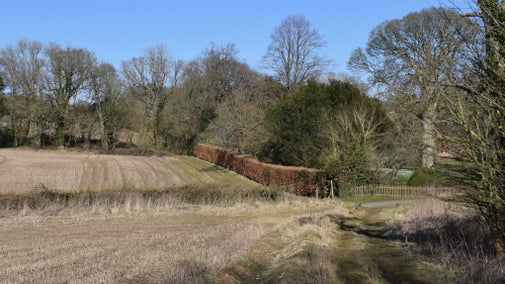Walk in Stanley Spencer's footsteps around Burghclere
Hampshire
This gentle circular walk takes in the places that painter Stanley Spencer lived, loved, and was inspired by during the years he lived in Burghclere, creating his epic First World War themed masterpiece – Sandham Memorial Chapel.
Near to
Sandham Memorial ChapelStart point
Sandham Memorial Chapel, Harts Lane, Burghclere, RG20 9JT. Grid ref: SU463608.Trail information
*Mainly paved road, with some walking on grass. For further details, please see Terrain section.
**Full route unsuitable for pushchairs or wheelchairs due to kissing gate and sloped terrain – shortcut available. For further details, please see section marked Access.
***Keep dogs on leads. For further details, please see section marked Facilities.
More near here
Mottisfont estate walk
Discover the beautiful, diverse Mottisfont estate on a varied circular walk through ancient woodlands, historic farmland and Mottisfont village.

Get in touch
Our partners

We’ve partnered with Cotswold Outdoor to help everyone make the most of their time outdoors in the places we care for.
You might also be interested in
Eating and shopping at Sandham Memorial Chapel
The small shop has a selection of mementos and books. Picnic spots provide ideal places to bring your own refreshments and enjoy the surrounding garden.

Walking in Hampshire
There’s so much to enjoy on a winter's walk in Hampshire. You can wander through magnificent beech woods at The Vyne, or take in breathtaking views across downland at Hinton Ampner. We've got walks to suit all ages, including young families, with fascinating facts to accompany each one.

Walking
Explore some of the finest landscapes in our care on coastal paths, accessible trails, woodland walks and everything in between. Find the best places to walk near you.

The history of Sandham Memorial Chapel
Discover all about this unique chapel and how 20th century artist Stanley Spencer came to create such an impactful memorial to everyday life in the First World War.

Staying safe at National Trust places
The special places in National Trust care sometimes come with a few risks for visitors, be it coastline or countryside. Find out how to keep safe throughout your visits.

Follow the Countryside Code
Help to look after National Trust places by observing a few simple guidelines during your visit and following the Countryside Code.

Cotswold Outdoor: our exclusive walking partner
Learn about the National Trust’s ongoing partnership with Cotswold Outdoor. Find out how they help us care for precious places and the exclusive discount available for National Trust supporters.


